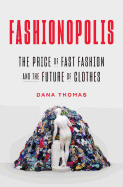
In the thorough and invigorating Fashionopolis: The Price of Fast Fashion--and the Future of Clothes, Dana Thomas suggests that being fashion-forward means knowing the origin story of our favorite pair of jeans.
Fashionopolis begins with a historical overview of the textile industry, which clings to two ideas from manufacturing's enduring 250-year-old, mass-production model: products must exist before they can be sold, and the more that are made, the cheaper the per-unit cost. In times of "fast fashion" and even faster machines, that's a recipe for a throwaway-clothes culture. Unfortunately, some apparent antidotes to the problem--Sewbots, 3-D printing and other environmentally friendly modern breakthroughs--come with other costs. She acknowledges that industry people have foretold that at a certain point, direct-to-consumer sales, while a move in the green direction, will mean the end of department stores. And, of course, robots, which promise efficiency that can keep down expenses for a conscientious company, kill jobs.
Thomas pins her hopes on the examples set by a batch of forward-thinking companies ranging in size from petite to extra-large. Stella McCartney, for instance, has long been a proponent of sustainability in the fashion industry, and Stony Creek Colors produces indigo, which, until the company's founding in 2012, hadn't been commercially farmed in the United States for more than a century.
Thomas (Deluxe: How Luxury Lost Its Luster) approaches Fashionopolis as both an intrepid investigative reporter and an aesthete. One of her many interviewees tidily fuses Thomas's two main concerns--the environment and good design--when she says, "If people still had seamstresses in their families, they wouldn't be chucking things away like they do." --Nell Beram, author and freelance writer

